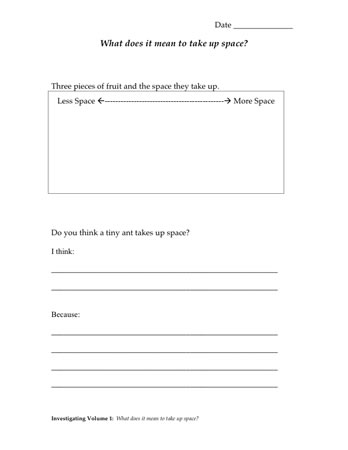What does it mean to take up space?
Plan Investigating Volume 1
Children are keenly aware of the size of things, especially big, bulky things that get in their way or are too unwieldy for their small bodies to handle. But the concept of volume is probably new to them, and it can be difficult for them to separate it from other measures that also describe an object’s size (e.g., weight, height, length, area, and perimeter).
In this investigation students consider what it means to “take up space.” First they brainstorm about the three dimensions of space, and then they order a set of objects by the amount of space they take up. By the end of the investigation, students will be thinking about volume as a property of objects different from weight. They will also have the beginnings of a “volume line.”
Learning Goals
- to consider what it means to “take up space”
- to compare the amount of space that objects take up
- to become familiar with the term “volume”
| Sequence of experiences | ||
|---|---|---|
| 1. Ask the question | All Class | 15 Mins |
| 2. Order objects by how much space they take up | Small Groups | 15 Mins |
| 3. Make meaning | All Class | 15 Mins |
Materials and Preparation
For the class:- Post the investigation question in a place where all students can see it
- 1 block of Styrofoam (approx. 10 cm x 10 cm x 20 cm)
- 1 pillar candle #1 (approx. 8 cm diameter x 16 cm tall)
- 1 small maple block (from 4 piece wood block set)
- Several creations from the 10–10–10–10 Challenge, if available
- 1 small cube (cubic centimeter block)
- 1 copper cube (from the set of materials cubes)
- 1 pine cube (from the set of materials cubes)
- 1 100–gram piece of plastic modeling clay





